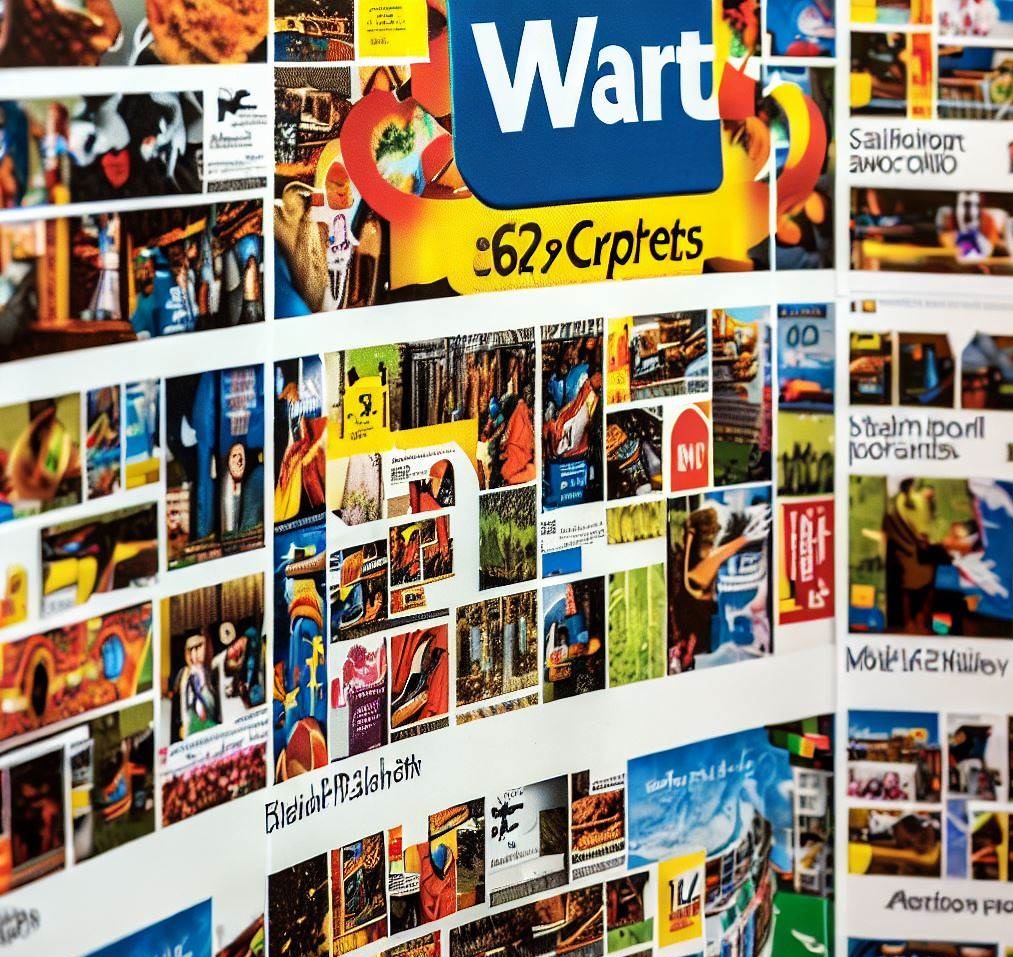
Exploring Retail Image and Symbolism
Wal-Mart’s advertising flyers, with their strategic use of retail image and symbolism, hold the key to unlocking the secrets of the company’s success. Through the lens of institutional semiotics, these flyers become a captivating reflection of Wal-Mart’s marketing strategy. Every element within the flyer is carefully designed to convey specific messages and evoke desired emotions from the audience. By analyzing the retail image and retail symbolism embedded in Wal-Mart’s advertising flyers, we can gain valuable insights into the symbolic connections the company establishes with consumers.
The retail image and symbolism employed in Wal-Mart’s advertising flyers have a profound impact on the perception of the brand. These flyers serve as powerful tools to shape Wal-Mart’s identity and position in the market. By incorporating symbols and imagery, such as smiling faces, happy families, and the iconic Wal-Mart logo, the company establishes a strong emotional connection with its target audience. The strategic use of layout, color schemes, and typography creates a sense of familiarity, reliability, and trust. This, in turn, contributes to the overall success of Wal-Mart in the retail industry.
Discover the fascinating world of Wal-Mart advertising flyers and their distinctive retail image. Unravel the symbolic puzzle presented by these flyers and understand the importance of retail symbolism in the marketing industry. Delve into the unique elements of Wal-Mart’s approach and how it connects with consumers on a deeper level.
The Success of Wal-Mart: A Retail Phenomenon
The success of Wal-Mart can be attributed to its adept utilization of retail image and symbolism. By carefully crafting their advertising flyers, Wal-Mart created a powerful narrative that resonated with customers. The use of symbols, such as smiling faces and happy families, evoked positive emotions and a sense of trust. Through consistent branding, Wal-Mart established itself as a reliable and affordable destination for shoppers. The strategic deployment of retail image and symbolism in their flyers allowed Wal-Mart to expand its reach and dominate the global retail market.
Explore the factors that have contributed to the incredible success of Wal-Mart. From its humble beginnings as a small town shopkeeper to becoming the world’s largest retailer, uncover the key strategies and practices that have propelled Wal-Mart to the top. Learn about the exemplary growth, leadership, and innovative approaches that set Wal-Mart apart from its competitors.
Institutional Semiotics and Wal-Mart’s Symbolic Connections
Wal-Mart’s advertising flyers, steeped in retail image and symbolism, act as powerful tools for forging connections with American consumers. These flyers depict scenes of everyday life, showcasing the role of Wal-Mart as a central figure in the American retail landscape. By employing symbols and visual cues that evoke familiarity and a sense of belonging, Wal-Mart cultivates a relationship with its customers, positioning itself as an integral part of American life. The strategic use of institutional semiotics in their advertising strategies has contributed to Wal-Mart’s enduring success and influence in the retail industry.
Dive into the realm of institutional semiotics and its application to Wal-Mart’s advertising flyers. Understand how Wal-Mart strategically aligns itself with the dominant ideologies of American life, fostering connections through symbols of family, community, and patriotism. Explore the values expressed by Wal-Mart and how they resonate with its consumer base.

Retail Image and Symbolism: Comparisons and Reflections
When examining Wal-Mart’s retail image in comparison to its competitors, the significance becomes evident. Through the analysis of Wal-Mart’s advertising flyers and their use of institutional semiotics, we uncover the unique strategies employed by the retail giant. These flyers serve as powerful tools for conveying Wal-Mart’s brand identity, establishing symbolic connections with consumers, and solidifying its success in the retail industry.
In the realm of retail image and symbolism, Wal-Mart stands out from its competitors. The carefully crafted advertising flyers of Wal-Mart not only showcase products but also reflect the aspirations and values of their target audience. Through the strategic use of visual cues and symbols, Wal-Mart establishes a deep emotional connection with consumers, fostering loyalty and reinforcing its position as a leading player in the market. The success of Wal-Mart lies in its ability to leverage retail image and symbolism to create a distinctive and resonant brand experience for customers.
Take a closer look at Wal-Mart’s retail image and compare it with other retailers in the market. Analyze the similarities and differences in their approaches to retail symbolism and image. Reflect on the impact of these strategies on consumer behavior and the broader retail landscape.
The Power of Wal-Mart’s Advertising Flyers
Wal-Mart’s advertising flyers invite us to explore the complex realm of retail image and symbolism. These flyers, viewed through the lens of institutional semiotics, provide a glimpse into Wal-Mart’s success and its profound ties to American life. By carefully analyzing the meticulously crafted visual elements and textual messages, we can uncover the embedded layers of retail image and symbolism. As a key tool in Wal-Mart’s marketing strategy, the flyer aims to actively communicate its brand identity and establish symbolic connections with the target audience.
Delve into the depths of Wal-Mart’s advertising flyers and uncover the hidden meanings behind their symbols and messages. Analyze the linguistic and visual elements used in these flyers and how they contribute to the overall retail image. Gain insights into the effectiveness of Wal-Mart’s advertising strategies and their impact on consumer perception.
Learning from Wal-Mart’s Success
There are valuable lessons to be learned from Wal-Mart, the leader in the retail industry. By examining the success of Wal-Mart and its innovative strategies, we can uncover insights that can be applied to other retailers. Wal-Mart’s effective use of institutional semiotics, particularly through its advertising flyers, showcases the power of retail image and symbolism. These tools enable Wal-Mart to establish strong symbolic connections with its customers, positioning itself as a trusted and convenient shopping destination.
Retailers can draw inspiration from Wal-Mart’s winning ways and incorporate them into their own strategies. Understanding the significance of retail image and symbolism, as demonstrated by Wal-Mart’s advertising flyers, can help retailers enhance their brand identity and resonate with their target audience. By leveraging the lessons from Wal-Mart’s success, retailers can strengthen their competitive position, attract loyal customers, and create a thriving business in the dynamic retail landscape. Applying these principles can pave the way for success and growth in the retail industry.
Learn from the success of Wal-Mart and discover valuable lessons that can be applied to the retail industry. Explore the key strategies, such as low-cost operations, vendor partnering, and customer service orientation, that have made Wal-Mart a dominant force in the market. Gain insights into how other retailers can adapt and thrive in a competitive landscape.
Conclusion
The power of retail image and symbolism should not be underestimated in today’s market. By analyzing Wal-Mart’s success, we can uncover the secrets to effective retail strategies. Additionally, Wal-Mart’s advertising flyers, which leverage institutional semiotics, exemplify how retail image and symbolism create strong connections with consumers. Furthermore, these flyers play a crucial role in shaping Wal-Mart’s brand identity and establishing its position as a trusted leader in the industry.
Understanding the significance of retail image and symbolism, as demonstrated by Wal-Mart’s advertising flyers, offers abundant opportunities for retailers. By strategically incorporating these elements, businesses can enhance brand perception and resonate with their target audience. Wal-Mart’s success stems from its ability to establish symbolic connections with customers through its flyers, positioning itself as the go-to destination for convenient and affordable shopping. By harnessing the power of retail image and symbolism, retailers can differentiate themselves, cultivate customer loyalty, and thrive in today’s competitive retail landscape.
In conclusion, the “Star Market Flyer” serves as a testament to the power of retail image and symbolism. Wal-Mart’s advertising flyers not only emphasize low prices but also reflect a deeper connection to American life and values
